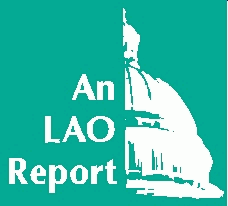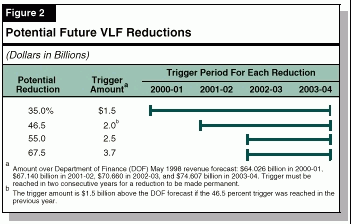

|
Chapter 2The 1998-99 Tax
|
As noted in Chapter 1, the 1998-99 Budget Act contains a significant tax reduction package. This package includes a number of ongoing tax reductions totaling roughly $1.4 billion in 1998-99. Beginning in 2000-01, additional tax cuts also are possible. Figure 1 summarizes the major tax-related provisions in the budget which are discussed below.
| Figure 1 | |
| Tax Relief Provisions | |
| 1998-99
(In Millions) | |
| Fiscal Impact | |
| Vehicle License Fee (VLF) | |
|
$533a |
| Personal Income Tax Dependent Credit | |
|
612 |
| Renters' Credit | |
|
133 |
| Senior Citizen Tax Relief | |
|
--c |
| Targeted Tax Cuts | |
|
52 |
|
54 |
| Total | $1,384 |
| a Full-year impact of the 25 percent VLF reduction is about $1 billion and would first occur in 1999-00. | |
| b Income limits are $25,000 (single taxpayers) and $50,000 (joint and head-of-household taxpayers). | |
| c Would not go into effect until 1999-00 at an annual cost of about $70 million. | |
| d Measures that would only go into effect if Proposition 7 (air quality tax credits) did not pass in November 1998. | |
| e Measures that would go into effect independent of the vote on Proposition 7. | |
The budget includes a permanent reduction in the vehicle license fee (VLF) of 25 percent, with the potential of greater reductions beginning in 200001 if General Fund revenues grow faster than currently projected.
The VLF is an annual fee on the ownership of a registered vehicle in California, levied in place of taxing vehicles as personal property. The fee rate is 2 percent of a vehicle's current estimated value--calculated from the current owner's depreciated purchase price. The revenues are distributed to cities and counties.
The permanent provision of the tax cut provides that beginning January 1, 1999, each vehicle owner's VLF owed will be reduced by 25 percent. The fiscal impact in 1998-99 will be about $500 millionwith the first full fiscal-year effect occurring in 1999-00 at about $1 billion.
The tax package also provides for additional cuts in the VLF beginning in 2000-01 under certain circumstances. If specified revenue forecasts (triggers) are reached, then the total reduction in the VLF could reach as much as 67.5 percent by 2002-03.
In order for any of these additional tax cuts to be made permanent, triggers would have to be reached for two consecutive years. The maximum level of ongoing VLF tax relief that could be achieved would be determined by the forecasted level of General Fund revenues at the time of the 2002-03 budget. The triggers for 2003-04 are used only to determine the ongoing level of tax relief and cannot trigger new reductions. The triggers are all based on the Department of Finance's 1998-99 May Revision revenue forecast for the 1998-99 through 2003-04 period.
Figure 2 shows these potential reductions, and the years during which they could be triggered. It shows, for example, that the 35 percent reduction has a four-year "trigger period." That means this reduction would be permanent if there were two consecutive years during the period when revenue growth hit the "trigger amount" (in this case, $1.5 billion above the specified forecast). By comparison, the 55 percent and 67.5 percent reductions can be permanent only if the trigger amounts are reached in both 2002-03 and 2003-04.

Cities and counties will continue to receive the same amount of revenues as under prior law, with the reduced VLF amounts replaced by General Fund spending. In any year in which the Legislature did not appropriate enough revenues to pay for the full amount of this backfill, the VLF tax cut would be reduced proportionately.
In the event that the Legislature passes additional tax relief beginning in 1999, the VLF measure requires that two calculations be made for any fiscal year in which the General Fund revenue loss from the new relief totals more than $100 million.
If, for example, the Legislature passed an additional $200 million in non-VLF tax relief effective in 2000-01, the following adjustments would be made. First, the trigger amount for 2000-01 ($1.5 billion) would be lowered by $200 million (to $1.3 billion) to reflect the reduced amount of expected revenues. Second, if the trigger amount was reached in 2000-01, the percentage reduction would be less than otherwise. It would be lowered to the level below 35 percent that provided $200 million less in VLF tax relief. (The base 25 percent VLF reduction would not be subject to these adjustments.)
The 1998-99 Budget Act agreement results in both an acceleration and increase in the personal dependent exemption credit allowed under the personal income tax. Under last year's tax relief package (enacted in September 1997), the dependent credit was to increase from $68 to $120 in 1998 and $222 in 1999. Under this year's budget agreement, the credit will instead increase by a larger amount$253 in 1998 and $227 in 1999. Thereafter, the $227 credit amount will be indexed annually for inflation.
The substantial increase in the credit in 1998--from $120 to $253--will lower revenues in 1998-99 by $612 million, compared to prior law. The smaller increase in the credit in 1999from $222 to $227will lower revenues by an estimated $20 million in 1999-00 and subsequent years.
The renters' credit program--which provides a tax credit to Californians who rent their principal place of residence--is reinstated for 1998, after having been suspended since 1993. In its reconstituted form, the renters' credit will be nonrefundable and income-limited. The amount of the credit is $60 for single renters and $120 for married couples or heads of households, but not to exceed the filer's tax liability. The credit will be made available to single renters with incomes up to $25,000, and to married couples or heads of households with incomes up to $50,000. For 1998-99, the impact of the revised renters' credit will be $133 million.
Two programs currently provide property tax assistance to low-income homeowners and renters who are either senior citizens (age 62 and older), disabled, or blind. For homeowners, the tax assistance is provided in the form of a partial reimbursement of property taxes paid; for renters, the amount of assistance is based on an estimate of the property tax paid by the renter. The budget plan increases the income eligibility limits from the current level of $13,200 to about $33,000 for 1999, and indexes the income limit based on inflation in future years. This provision will have a fiscal impact beginning in 1999-00, at an annual cost of approximately $70 million.
The budget contains a variety of other, targeted tax relief measures, totaling some $106 million in 1998-99. Of this total, $52.4 million would take effect only if Proposition 7 (the California Air Quality Improvement Act) is defeated in the November 1998 election. (Proposition 7 allocates up to $218 million in tax credits annually over 13 fiscal years, for expenditures designed to improve air quality.) The remaining $54 million in targeted tax reductions will take effect regardless of the election outcome of Proposition 7.
Figure 3 breaks out the $106 million in targeted tax measures included in the budget by individual provision, and shows their five-year fiscal effects. The top section of the figure identifies the tax provisions which are independent of the vote on Proposition 7 (as noted earlier, these account for $54 million in 1998-99 tax relief). Among these, the largest single reduction is for lowered horse racing fees, which is estimated to cost $20 million in 1998-99 and $40 million annually thereafter. The federal conformity measure basically brings several provisions of the California personal income tax and bank and corporation tax laws into line with changes made in federal tax laws during 1997 (per the federal Taxpayer Relief Act of 1997 and the Balanced Budget Act of 1997). The tax credit provision for the Joint Strike Fighter has no initial fiscal impact, but results in reductions beginning in 2000-01, reaching $64 million in 2002-03.
| Figure 3 | |||||
| Targeted Tax Relief Provisions | |||||
| (In Millions) | |||||
| 1998-99 | 1999-00 | 2000-01 | 2001-02 | 2002-03 | |
| Provisions Independent of Proposition 7 | |||||
| Reduced horse racing fees | $20.0 | $40.0 | $40.0 | $40.0 | $40.0 |
| Federal conformitya | 34.0 | 29.0 | 32.0 | 38.0 | 39.0 |
| Joint Strike Fighter credit | -- | -- | 5.0 | 61.0 | 64.0 |
| Subtotals | $54.0 | $69.0 | $77.0 | $139.0 | $143.0 |
| Provisions Dependent on Proposition 7 | |||||
| Research and development credit | $15.0 | $18.0 | $20.0 | $17.0 | $18.0 |
| Employer child care credit | 10.0 | 11.0 | 13.0 | 15.0 | 17.0 |
| Manufacturers investment credit software | 6.0 | 7.0 | 8.0 | 9.0 | 10.0 |
| Medical insurance deductible | -- | 12.0 | 14.0 | 16.0 | 18.0 |
| Minimum franchise tax | 4.0 | 11.0 | 11.0 | 11.0 | 11.0 |
| Sales and use tax exemptions | 11.4 | 22.8 | 22.8 | 22.8 | 22.8 |
| Otherb | 6.0 | 6.0 | 6.0 | 6.0 | 6.0 |
| Subtotals | $52.4 | $87.8 | $94.8 | $96.8 | $102.8 |
| Totals | $106.4 | $156.8 | $171.8 | $235.8 | $245.8 |
| a Miscellaneous conformity measures, including student loan interest deductions, home office deductions, expensing of environmental remediation costs, employee stock option programs (ESOPs) for 1995, and deductible self-employed medical insurance for 1998. | |||||
| b Includes estate tax reductions, and the expansion and extension of enterprise zones. | |||||
The $52.4 million in tax reductions in 1998-99 that are dependent on the defeat of Proposition 7 are shown in the lower part of Figure 3, along with their out-year impacts. The bulk of these reductions would accrue to businesses, through the personal income tax, bank and corporation tax, and sales and use tax. Among the more important reductions with respect to business activity are the expansion of the research and development credit, the eligibility of software development for the manufacturer's investment credit, and the reduction in the minimum franchise tax for new corporations. New sales and use tax exemptions are created for perennial plants, teleproduction equipment, and personal property purchased for space launch activities.
Return to The California State Spending Plan, Chapter 1--Table of Contents